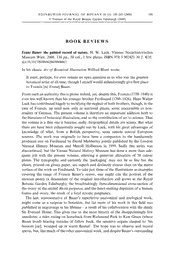
Franz Bauer: the painted record of nature. H. W. Lack PDF
Preview Franz Bauer: the painted record of nature. H. W. Lack
EDINBURGH JOURNAL OF BOTANY 66 (1): 199–203 (2009) 199 (cid:2)Trustees of the Royal Botanic Garden Edinburgh (2009) BOOK REVIEWS Franz Bauer: the painted record of nature. H. W. Lack. Vienna: Naturhistorisches Museum Wien. 2008. 130 pp., 58 col., 1 b/w plates. ISBN 978 3 902421 30 2. V35. doi:10.1017/S0960428609000067 In his classic Art of Botanical Illustration Wilfred Blunt wrote: It must, perhaps, forever remain an open question as to whowas the greatest botanicalartistofalltime,thoughImyselfwouldunhesitatinglygivefirstplace to Francis [ne´ Franz] Bauer. Fromsuchanauthoritythisispraiseindeed,yet,despitethis,Francis(1758–1840)is evenlesswellknownthanhisyoungerbrotherFerdinand(1760–1826).HansWalter Lackhascontributedhugelytorectifyingtheneglectofbothbrothers,though,inthe case of Francis, up until now only in scattered places, some inaccessible to non- readers of German. The present volume is therefore an important addition both to theliteratureofbotanicalillustration,andtothecontributionofarttoscience.That the volume is a thin one is because, sadly, biographical details are scanty. But what there are have been exhaustively sought out by Lack, with his great advantages of knowledge of what, from a British perspective, seem remote central European sources. The work was originally to have been a companion to the handsomely produced one on Ferdinand by David Mabberley jointly published by the London Natural History Museum and Merrill Holberton in 1999. Sadly this series was discontinued, but the Vienna Natural History Museum has done a more than ade- quate job with the present volume, allowing a generous allocation of 58 colour plates. The typography and certainly the ‘packaging’ may not be as fine but the plates, printed on glossy paper, are superb and distinctly clearer than on the matte surfaceoftheworkonFerdinand.Totakejustthreeoftheillustrationsasexamples covering the range of Francis Bauer’s oeuvre, one might cite the portrait of the moutan peony (a descendant of the original introduction still grows at the Royal Botanic Garden Edinburgh); the breathtakingly three-dimensional cross-section of theovaryoftheorchidBletiapurpurea;andtheheart-meltingdepictionofahuman foetus and ovary, the result of a fatal ectopic pregnancy. The last, representative of Bauer’s superlative anatomical and zoological work, might come as a surprise to botanists, but far more of his work in this field was published as engravings in his lifetime – a result of his collaboration with the shady Sir Everard Home. This gives rise to the most bizarre of the disappointingly few anecdotes: a rider racing on horseback from Richmond Park to Kew Green (where Bauer lived) bearing testicles of fallow buck, the sensitive organs clasped to ‘his bossom [sic], wrapped up in warm flannel’. The hope was to observe and record sperm,but,likemuchoftheotheranatomicalwork,anddespiteBauer’soutstanding 200 BOOK REVIEWS microscopical skills, it was foiled not only by optical limitations, but by the poor fixation and staining techniques of the time. The story of Francis’s life is clearly and succinctly told by Lack:from his days as a precocious teenager painting, with his brothers, for the ‘Codex Liechtenstein’, followedbyalittle-documentedperiodworking,againwithFerdinand,forNikolaus vonJacquininViennawherethebrothersbothlearnedtoetch.Lackaptlycompares the exquisite draughtsmanship and precocity of the brothers with the music of Mozart, whom they could well have met in the Jacquin household. Bauer accom- panied Jacquin’s son on a tour of northern Europe, ending up in London in 1788, whereBauerwasenticedtostaybySirJosephBanks,whogavehimtheastonishing annualsalaryof£300,forlife,topaintplantsatKewatatimewhenEnglishgarden novelties were being artistically poached by L’He´ritier in Paris. Bauer remained at Kew until his death in 1840 at the age of 82. Thevastmajorityoftheresultingbotanicaldrawingswereneverpublished–many wereunfinished,andsubsequenttrimmingandre-annotationmeanthatchronology and sources of the plants depicted are often impossible to establish. Though Bauer hadlittleformaleducationhewasregardedbyBanksandHomeasascientificequal, and he was elected FRS in 1820. Bauer published several papers and three ‘books’, though two of the latter (on Erica and Strelitzia) have no text – the drawings themselves‘intendedtoansweritselfanyquestionabotanistcanwishtoask’.Some of the drawings show important processes such as pollen germination, and others correctly interpret complex structures such as the staminal and stigmatic structures of Asclepiadaceae, the interpretation and clarity of depiction implying a clear understanding of theory. His work on rust fungi and plant pathology was also pioneering but, because most of these drawings were not published, either with or without explanatory text, they failed to contribute to scientific knowledge. In fact this led to problems, and John Lindley took up cudgels on Bauer’s behalf, claiming that Robert Brown had failed to acknowledge the priority of Bauer’s work on Orchidaceae, probably his favourite family. The implication of plagiarism was unjustifiedandBrownpublishedaglowingtributetothebrothersandtheirscientific contribution in the second of his two great papers on Rafflesia. These papers are adornedwithnofewerthan13platesbyFrancis,andfourofFerdinand’slastworks, interpretedbythevirtuosicengravingofJamesBasire–resultinginsomeofthemost beautifulscientificplatesevermade.Thisraisesthequestionofhowself-sufficient,as scientific statements, pictures without words can be (a question repeatedly revisited since the dawn of the Enlightenment, for example in the circle of Galileo and the Linceans in Rome). Sadly the answer was pointed out in 1844 by William Griffith, who learnt so much both from Brown and Bauer before his Indian travels: ‘had he [FrancisBauer]beenawriterandnotadrawer,before1800,ingreatprobabilitywe should have known nearly as much of embryogeny as we do now’. The artist’s understanding may leap from the page, but it has to be elaborated in words. As a resultof Banks’s generosity (and acurious episode involvingPrince Albert), mostofFrancisBauer’sdrawingsarenowintheNaturalHistoryMuseum,London, BOOK REVIEWS 201 with a smaller collection in Go¨ttingen (including a unique hand-coloured set of the anatomical prints bought after Bauer’s death by Ernst August, King of Hanover, whose life, after an attack by his valet, had been saved by Sir Everard Home). A greatdebtisduetoProfessorLackformakingtherichnessofFrancisBauer’swork accessible in this affordable publication. H. J. Noltie
